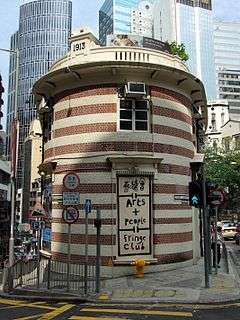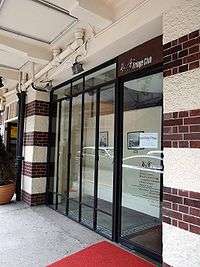Fringe Club
| 藝穗會 | |
 | |
| Formation | 1984 |
|---|---|
| Type | Not-for-profit arts organisation |
| Headquarters | 2 Lower Albert Road, Central, Hong Kong |
Director | Benny Chia |
Chairman | Wailee Chow |
|
Anson Chan Antony Szeto Wu Chi Wai Douglas Young Chi-chiu | |
| Website |
hkfringeclub |

The Fringe Club (Chinese: 藝穗會) is a not-for-profit arts organisation. Its mission is to help emergent artists, promote Hong Kong artists abroad through cultural exchange and overseas touring, and conserve and develop Hong Kong cultural heritage.
It provides rent-free contemporary arts space for exhibitions and performances. It is located in 2 Lower Albert Road, Central District. It is housed in a Grade-I heritage building, the old Dairy farm cold storage depot, built circa 1892 in a late Victorian eclectic style. The facade of this building is distinguished by its "blood and bandages" brickwork.
History
In 1892, Dairy Farm built a low-rise brick and stucco building on Lower Albert Road in Central for use as a cold storage warehouse. This warehouse was later renovated and expanded in 1913 to include a dairy shop, a room for meat smoking, a cold storage room for winter clothes and residency for the general manager. The building later evolved into the company headquarters until the company moved in the 1970s. The abandoned building was acquired by the Hong Kong Fringe Club in 1984.
The building has undergone many major renovations to make it a vibrant place for contemporary arts since the Fringe Club moved in, in 1983. In 2001, the building won a Hong Kong Government Heritage Award for its use of the building.[1] It has been categorised as a Grade I historic building.[2]
Arts venues
The Fringe Club has two studio theatres, three exhibition areas (including a photography gallery), a rehearsal room, a restaurant, a roof garden and offices. It features and promotes theatre, dance, music and exhibitions.
It has an open access policy and – for many young local artists – provides venues, publicity support, and occasional opportunities to go on tours overseas.[3]
In 2006, the club was used as the base for six art festivals. It also occasionally produces its own theatrical performances, art exhibitions and site-specific works.
Over the past two decades, more than 500 arts groups from Asia, Australia, Europe, North and South America have used the premises for cultural exchange activities.
In 2006, the club presented the City Festival putting the spotlight on Singapore to promote cultural exchange advocated in the Memorandum of Understanding signed between the governments of Singapore and Hong Kong.
The club provides 'rent-free' exhibition and performance facilities to Hong Kong and mostly international artists and performers. According to some sources it takes 30% of sales income from artists and performers.
The operation of this organisation is supported by Hong Kong Arts Development Council and earned incomes from its food and beverage facilities, ticket sales, advertising, membership fees, sponsorship and donations.
References
External links
| Wikimedia Commons has media related to Fringe Club, Hong Kong. |
Coordinates: 22°16′49″N 114°09′21″E / 22.28014°N 114.15575°E